ARM A53/A57/T760 investigated - Samsung Galaxy Note 4 Exynos Review
by Andrei Frumusanu & Ryan Smith on February 10, 2015 7:30 AM ESTGPU Performance
In the graphics department we're matching up Qualcomm's Adreno 420 versus the Mali T760MP6. The Adreno is running at 600MHz and is able to benefit from almost double the memory bandwidth at 25.6GB/s versus 13.2GB/s due to the Snapdragon's increased 128-bit memory interface. Let's look at how both compare in our overall benchmarks:

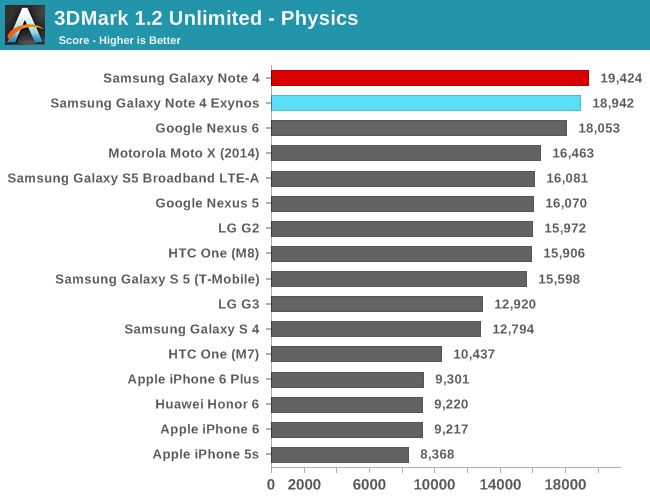
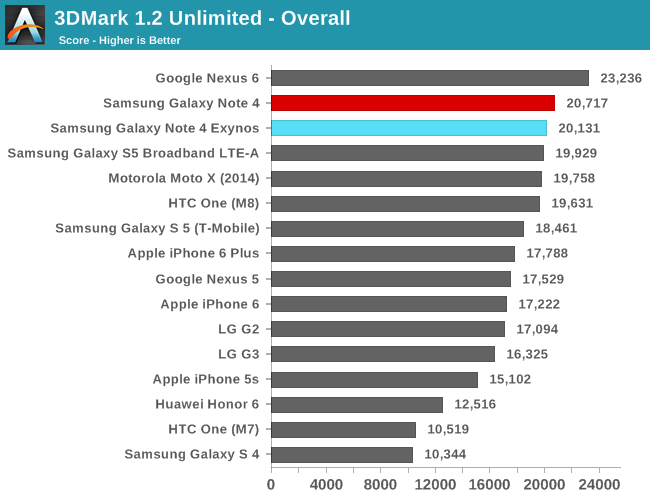
In 3DMark Unlimited the Exynos version comes just short of a few fps behind the Adreno 420. What is also surprising is that the Exynos 5433 performs much better in the physics score than I had anticipated; the same test on Huawei's SoCs limited the thread onto the little cores in the default settings giving mediocre performance results. However, it seems the A53 is performing much better and is able to match Qualcomm's offering now.
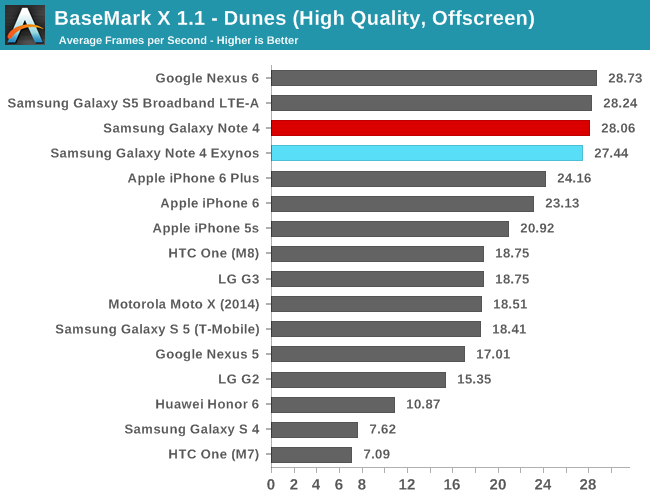
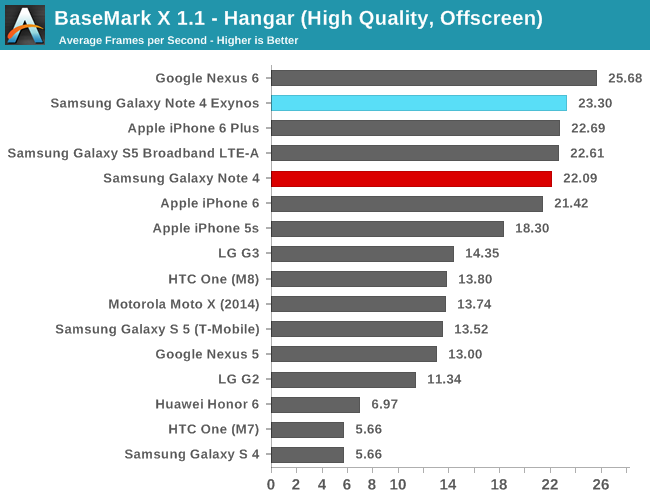
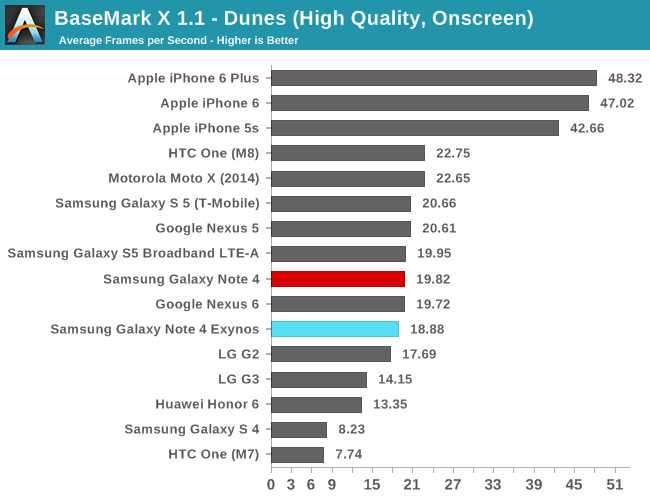

In BaseMark X 1.1, the Exynos is again neck-and-neck with the Snapdragon version. It loses by a slight margin in the Dunes benchmark while winning in the Hangar scenes by a similarly small margin. BaseMark X is again one of the benchmarks that can trigger the 700MHz state of the Mali GPU, offering higher performance at a much higher power draw depending on which scene is currently rendered on both tests.
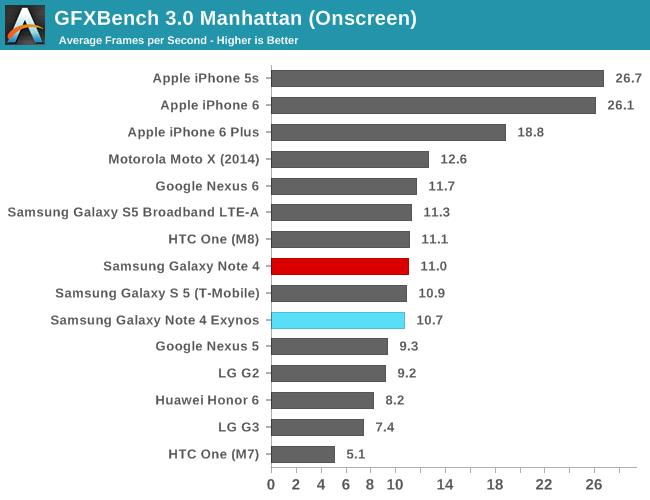
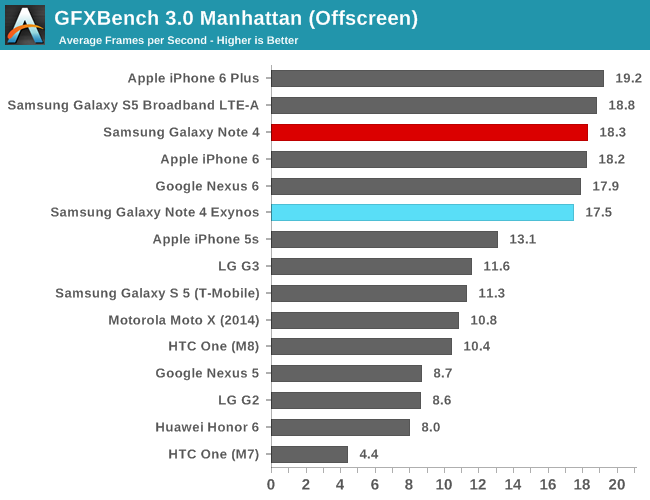
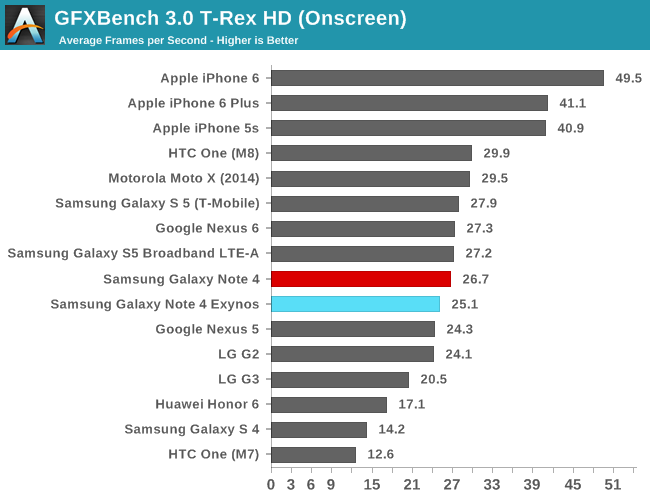
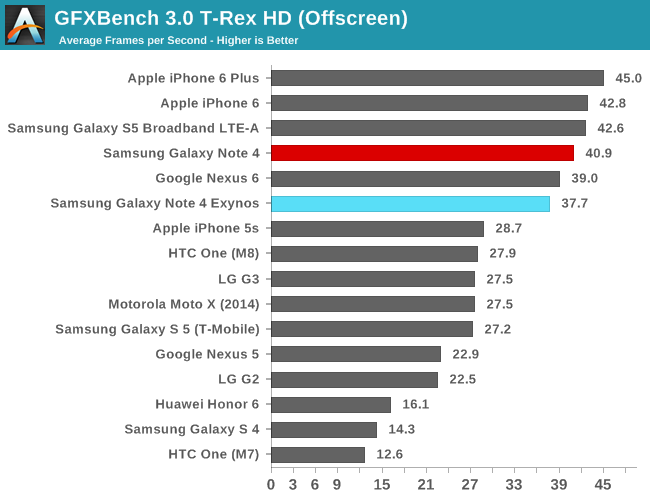
Again we continue to see the same pattern in GFXBench's scenario benchmarks, with the Exynos version lagging a few frames behind the Qualcomm GPU in both Manhattan and T-Rex, in both on-screen and off-screen results.
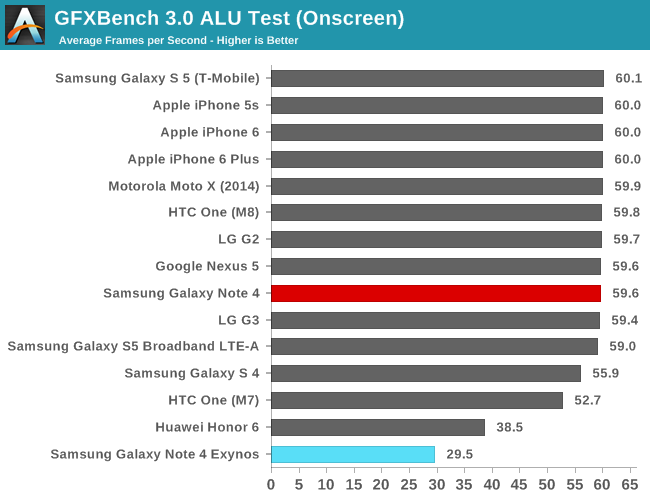

It's on the synthetic tests that we finally see some major deviation between the two architectures. ARM's Mali simply can't seem to keep up with the ALU throughput of Qualcomm's architecture. Both the Adreno 330 and 420 have a clear computational power advantage, exceeding even Imagination's PowerVR GPUs in the iPhones, leaving Mali strictly on the lower end of the performance spectrum.
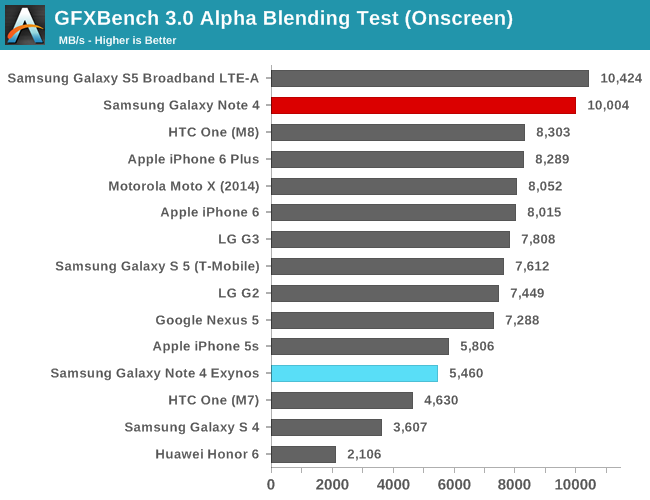
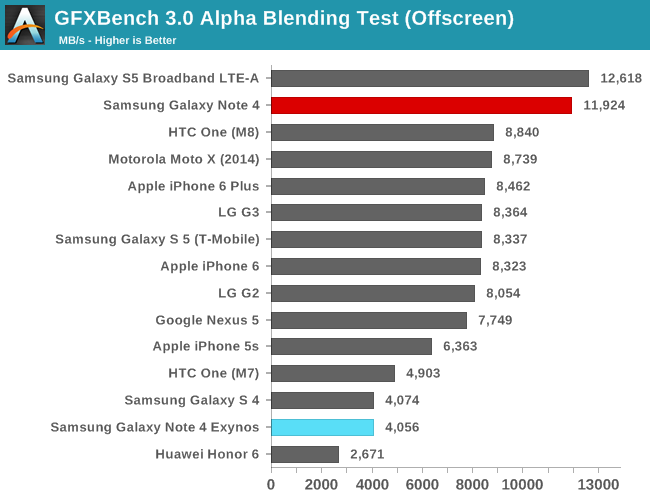
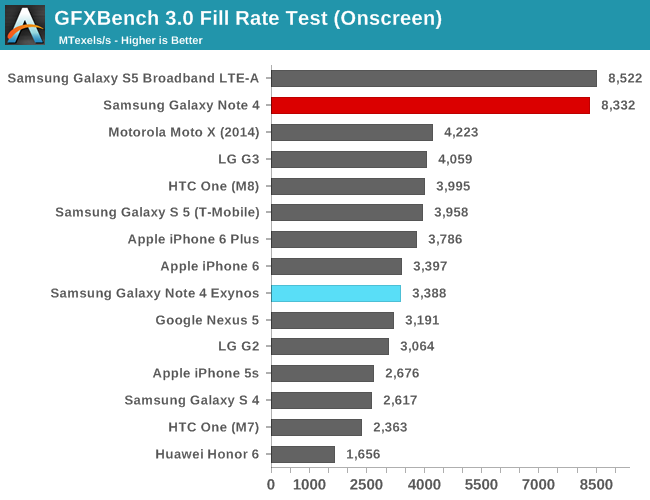
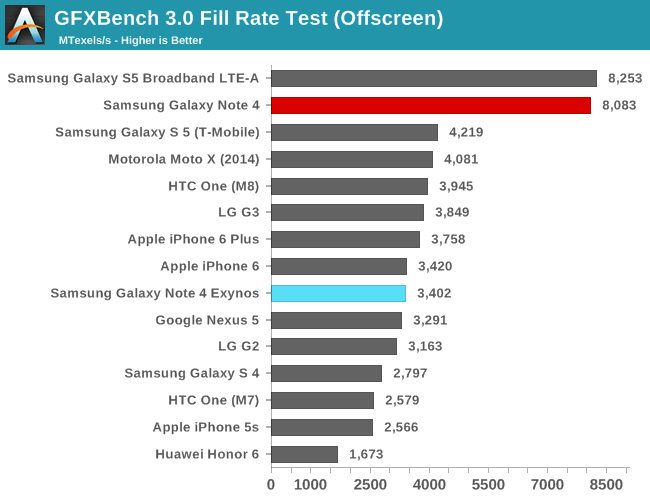
We see a similar situation in the Alpha Blending and Fillrate tests, as the Adreno offers 2-3x the throughput. Utilizing the extra memory bandwidth here seems to be key to the success of the Snapdragon 805's graphics performance.

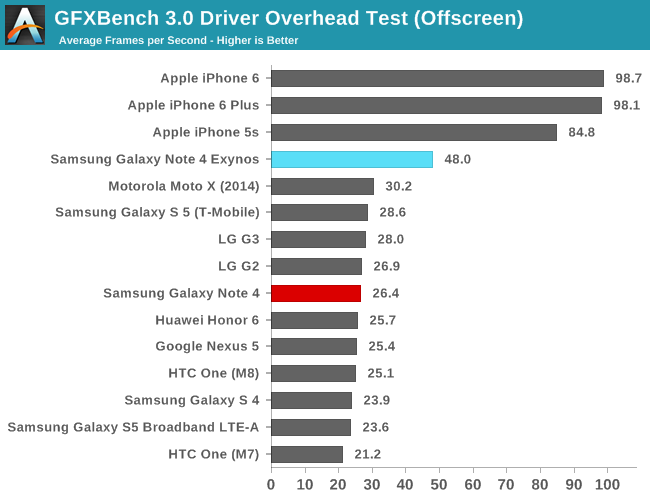
I've already mentioned the Driver Overhead score in the the more in-depth analysis of the T760. It's the first Android device to truly stand out from the rest of the crowd, finally making some progress into trying to catch up with Apple's excellent performance on iOS. Here's hoping more vendors concentrate on improving this metric in future driver updates.
I did some extensive power measurements on the Note 4 Exynos in this review, so naturally we're keen to see how this transforms into our battery benchmarks on the next page.










135 Comments
View All Comments
Sonicadvance1 - Tuesday, February 10, 2015 - link
"The overall increase in cache helps to improve performance, though perhaps more importantly the larger instruction cache helps to offset the larger size of the 64-bit ARM instructions."This is incorrect. AArch64 has a 32bit instruction length just like ARMv7.
Unless of course you were comparing to 16bit Thumb instructions. Vague in either case.
jjj - Tuesday, February 10, 2015 - link
Wish you would have included power numbers for A15 and A7 on 28nm since that's the more common process for A15/A7 and it's unlikely we'll see them much on 20nm and bellow (to be clear, not saying that you should have excluded the numbers on 20nm).Said this before, very curious about the encryption gains in actual use for both power and perf so maybe you guys look at that at some point. And maybe include https sites in the web browsing battery tests- tests that are kinda fuzzy on the methodology, maybe you've detailed it somewhere and i just don't remember.
The process scaling is surprising, maybe TSMC did better,we'll have to see.
Any clue how A53 power scales at much higher clocks, obviously not from this testing. Wondering how it would perform at very high clocks vs a lower clocked A57. At.1.3GHz the A53 seems to use some 3 times less power than A57 and given it's die size if it could go to 2.5Ghz on 20nm it would be interesting, at least from a cost perspective.
Andrei Frumusanu - Tuesday, February 10, 2015 - link
I only have a S4 with an 5410 at disposition, and that is running cluster migration and it's a very old chip by now. The only other candidates would have been the 5422 S5 variant which I don't posses, or to have to destroy the unibody shells of my Huawei devices to be able to do a proper power measurement.I did overclock the A53, but above 1.5GHz it's not worth running the little cores as the voltage rise is too high and the A57's at low frequency are more efficient. This is highly dependent on the core implementation, I imagine MediaTek's SoCs with high clocked "little" cores are much better optimized in such scenarios.
jjj - Tuesday, February 10, 2015 - link
Thanks for the reply.I kinda like the A53 perf at 1.5GHz and above ,nice little core and nice boost for the market it's addressing. In this SoC it does seem that above 900MHz the power goes up a lot.
Devo2007 - Tuesday, February 10, 2015 - link
Interesting to see the PCMark numbers, and how Lollipop seems to help. Given that Lollipop overall "feels" smoother, it makes sense there would be something that would allow that to be somewhat measurable.Running an early build of CM12 on my Snapdragon Note 3, and I'm seeing numbers nearly on-par with the Nexus 5 shown here.
Pissedoffyouth - Tuesday, February 10, 2015 - link
I'm running CM12 on my Note right from from an early Temasek build. Absolutely love it, and there aren't too many showstopping bugs.I hope they do put note 3 on this graph.
Devo2007 - Tuesday, February 10, 2015 - link
Yup! Teamasek 7.5.1 as of today for me (was on 7.4 when I wrote that post). Absolutely loving it now, and feel comfortable using it as my daily driver.Ranger101 - Tuesday, February 10, 2015 - link
This is the most interesting and relevant technical read I have had for some time.An excellent article.
Well done Messrs Frumusanu and Smith.
juicytuna - Tuesday, February 10, 2015 - link
Monster of an article. Will take me many rereads to take it all in.This is what Anandtech is all about, this is what separates it from the rest.serendip - Tuesday, February 10, 2015 - link
Excellent article, I really appreciate the in-depth analyses on the differences between the Exynos and SnapDragon SOCs. I'm shaking my head at Samsung's mad product line though. They seem to make a different variant for each region with so many SOC/modem/RF combinations.Wouldn't it be better to have just one or two variants supporting most of the LTE frequencies out there? I would hate to be the person at Samsung in charge of software updates for these phones. You would need a huge developer team to keep track of per-device changes and fixing bugs while keeping the code consistent along the same model line.